1. Orlando, by Virginia Woolf (1928)
There are approximately ten bajillion English-language editions of Orlando from a number of different publishers, and most aren’t straight-up reprints. It seems each publisher took their own approach to conveying the book’s subject matter — generally by not conveying anything at all.
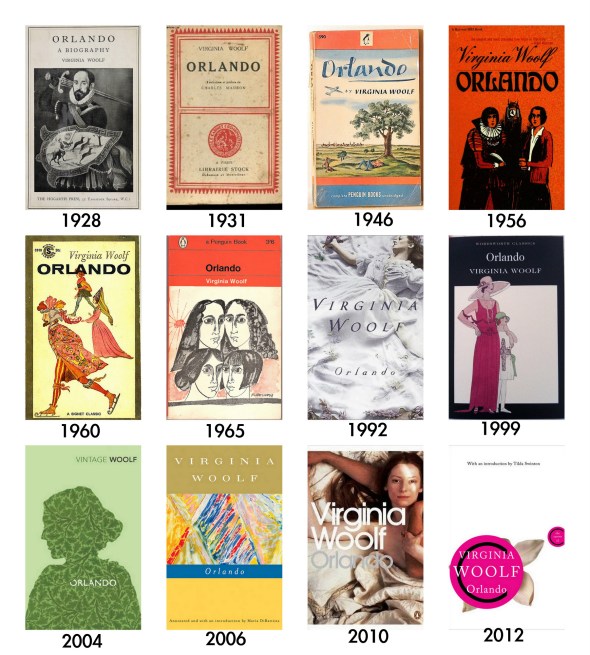
2. The Well Of Loneliness, by Radclyffe Hall (1928)
This is one of the most depressing and the most controversial books of all time, which means it had to suffer through an obscenity trial and other legal actions, including customs seizures, in the U.S. and Britain, before it could be sold openly. The 1951 cover, which features women dressed like it’s the ’50s even though the book took place decades earlier, describes its contents as “the strange love story of a girl who stood midway between the sexes.” The 1974 edition tried a little harder to be true to the time period, but the ladies are in heavy makeup wearing historically inaccurate costumes. After a 1981 foray into the wilds of terrible/AWESOME, it seems in the ’90s they abandoned attempting to picture actual lesbians on the cover and began using fine art instead. Personally I feel a more accurate cover would be a picture of me stabbing my eyes out with DON’T READ THIS BOOK in large block letters over my face.

3. The Price Of Salt, by Patricia Highsmith (1951)
Patricia Highsmith, best known to the masses as the author of the book that became The Talented Mr. Ripley, published her lesbian novels under the name “Claire Morgan.” As time passed and it became okay to be gay, Highsmith’s novels were printed using her real name. International editions and the most recent English-language version I could find use a different title, “Carol,” the love interest of the book’s protagonist (Therese).

4. Rubyfruit Jungle, by Rita Mae Brown (1973)
Tiny feminist press Daughters Publishing Company produced the first edition of this novel, which caught the eye of Bantam Books, who reprinted Rubyfruit Jungle in 1977, where it became the first mainstream U.S. besteller with lesbian themes. Honestly, I still like the 1973 cover the best.
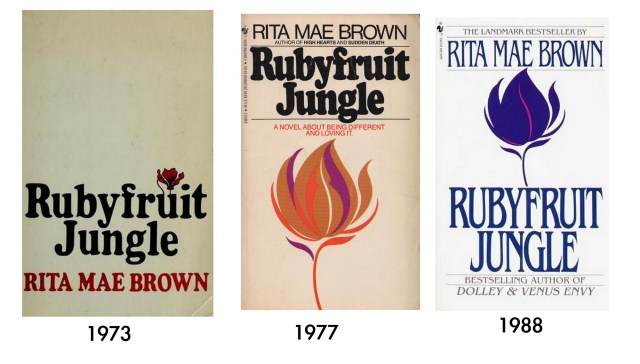
The American versions throughout history are coy about the subject matter, to say the least. Overseas, things were a little more direct.
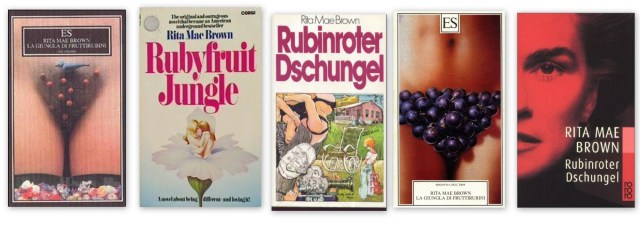
5. The Color Purple, by Alice Walker (1982)
Then 1985 cover comes from the film, and the 2006 cover from the Broadway musical. AS per ushe, I like the first one the best.
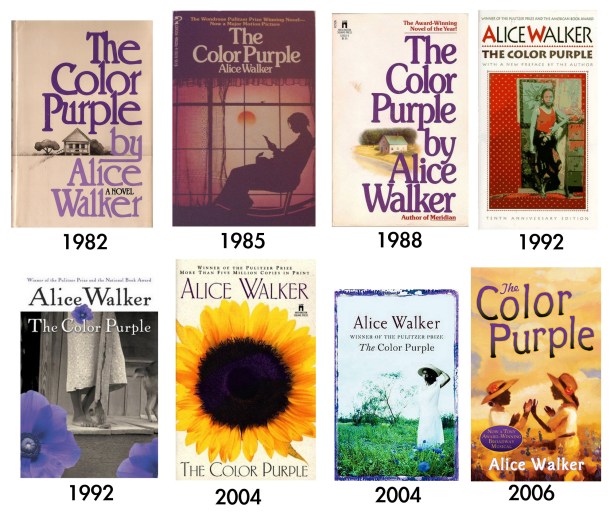
It seems like in the international editions, publishers were more eager to put heads, rather than flowers, on the cover:
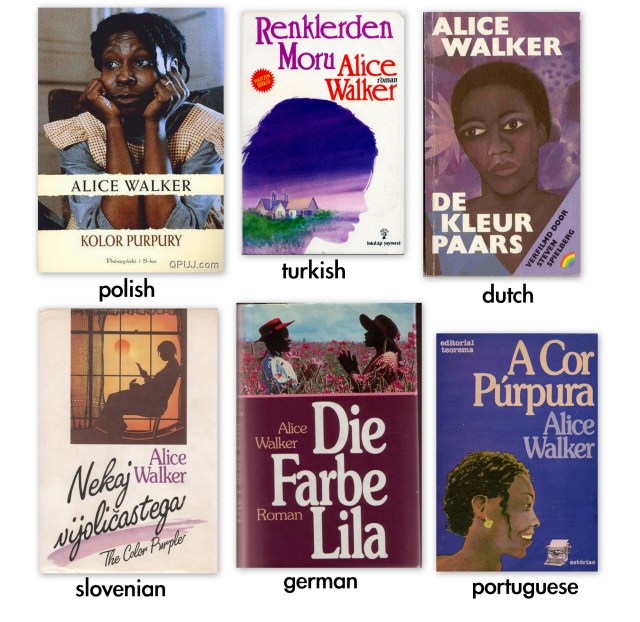
6. Annie on My Mind, by Nancy Garden (1982)
Nancy Garden hated the first cover designed for Annie on My Mind, which pictured Liza and Annie on the Esplanade in Brooklyn, with Liza standing away from Annie. Garden said, “it really looks as if Annie is going to swoop down on Liza — almost like a vampire attacking.” She didn’t like the next cover design either, because she wanted to see “the two girls really relating to each other equally.” Finally she got what she wanted, ten years later.
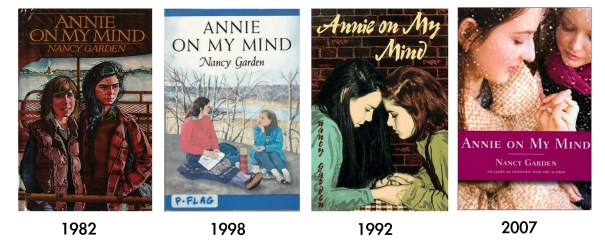
7. Sister Outsider, by Audre Lorde (1984)
The Crossing Press in California, founded in 1963, published Sister Outsider back in 1984 and featured a photograph of Lorde, taken by Salimah Ali. Crossing Press was purchased by Ten-Speed Press, a Berkeley-based press founded in 1971, in 2002, which was subsequently purchased by Crown Publishing, a division of Random House.
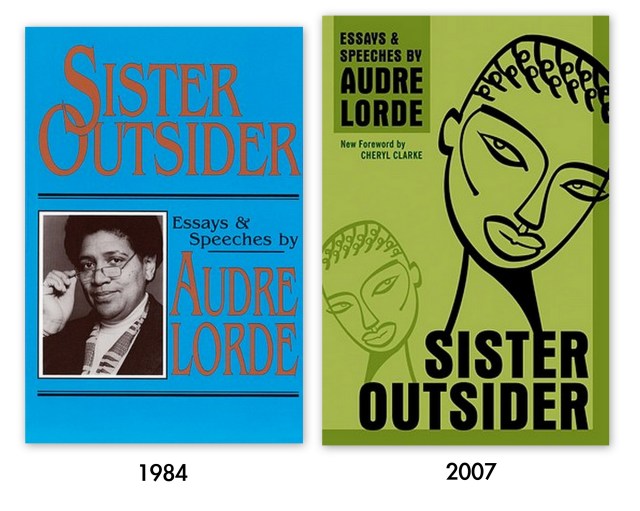
8. Oranges Are Not The Only Fruit, by Jeanette Winterson (1985)
Anita Kuntz illustrated the picture on the cover of the 1987 edition, and Olaf Hajek illustrated the second 1997 cover illustrated below. Hajek also designed the covers for relaunches of Winterson’s Sexing the Cherry and The Passion. The 2011 cover is part of Vintage 21, 21 books released by Vintage to celebrate their 21st birthday and if you buy all 21, you will have a beautiful rainbow on your bookshelf.
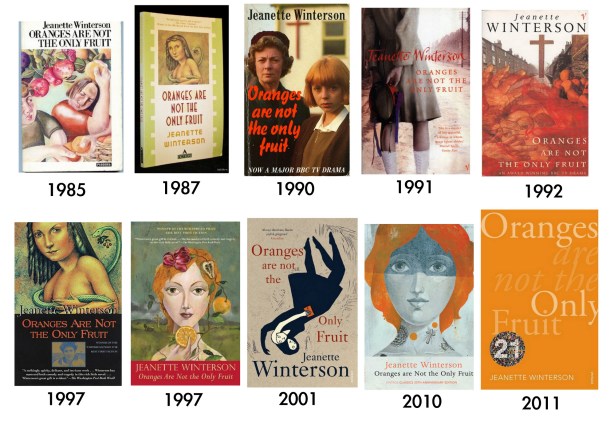
9. The Gilda Stories, by Jewelle Gomez (1991)
The woman pictured on the original cover is Gomez’s great-aunt Effie. Although Gomez never met Effie, she recalls that her great-grandmother heard Effie’s voice calling to her after she died, a story which Gomez says “shaped my writing forever.” The new edition hints more strongly at the book’s content: VAMPIRES!
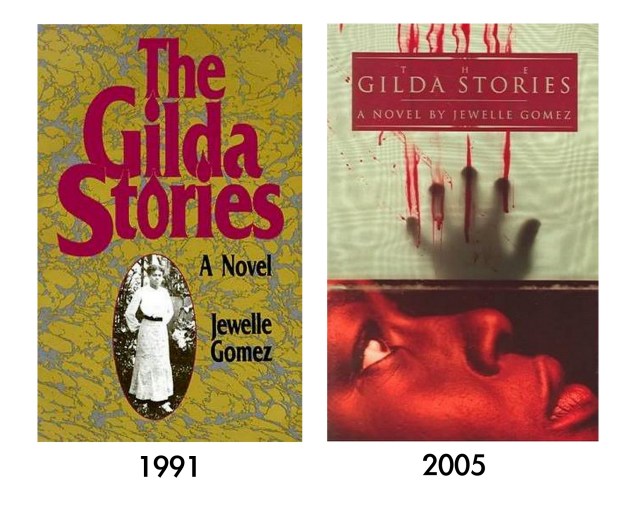
10. Bastard Out of Carolina, by Dorothy Allison (1992)
The 1993 Flamingo imprint is super-weird, it looks like a book about a teenage pyromaniac. I’d like to conference with whomever signed off on that one. The 2012 20th Anniversary Collection cover, though, is pretty awesome, and the cover art is the work of queer lady Jessica Sabogal, “a first generation Colombian American graffiti artist, hip-hop dancer, toymaker, and photographer.”
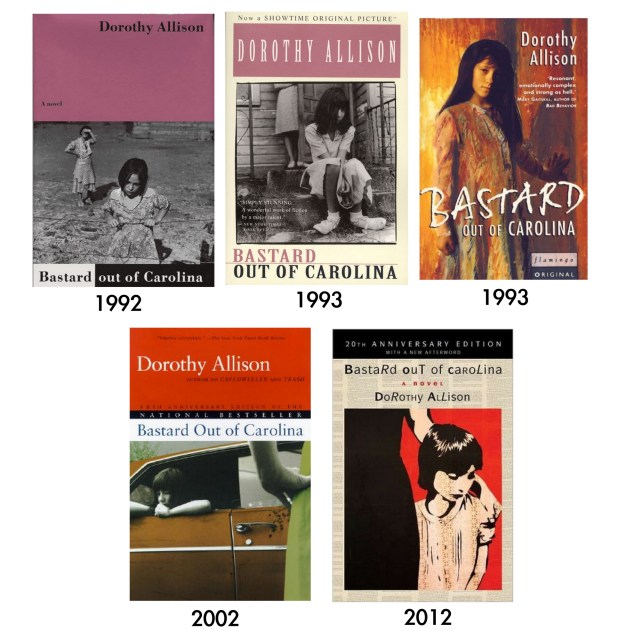
I also really like the French cover:
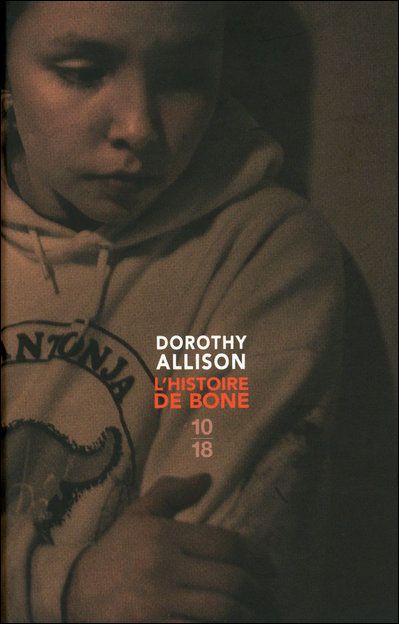
11. Stone Butch Blues, by Leslie Feinberg (1993)
It’s really interesting that they chose to go from a younger picture of the author to an older one with the new edition, even though the narrator, I presume, remains the same age. It really serves to bring the author’s whole life to bear upon the book.
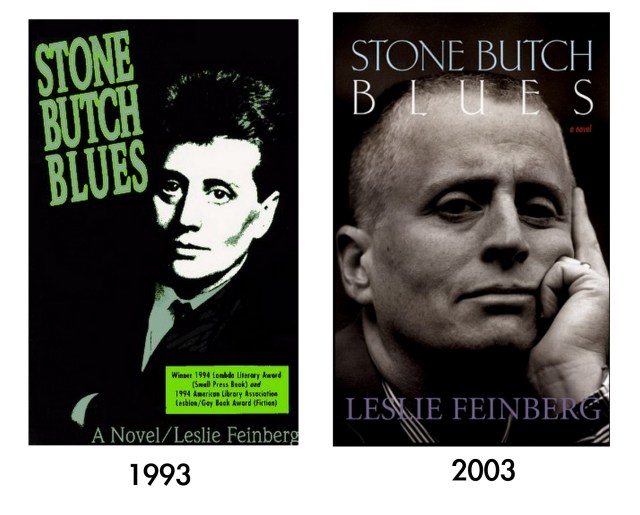
My favorite take on it is actually the Chinese cover from 2006:

12. Tipping the Velvet, by Sarah Waters (1998)
My edition of Tipping the Velvet looks a lot like the original American imprint, published in 1999, and described in The New York Times as “a mildly troubling picture, one that immediately arouses curiosity. You want to know more about the occasion; you scold yourself for being titillated; you find yourself noticing that the photographer has distanced the girls from the audience: the charms they so frankly display are out of reach and will remain so.”
The cover using the BBC adaptation’s actors might actually be the best representation of the novel’s content, though I always find it impossible to separate any face I’m shown on the cover from the character described within. The 2012 Mass Market paperback edition of Tipping the Velvet is a curious choice; foregoing humans and shoes in favor of a top hat and cane.
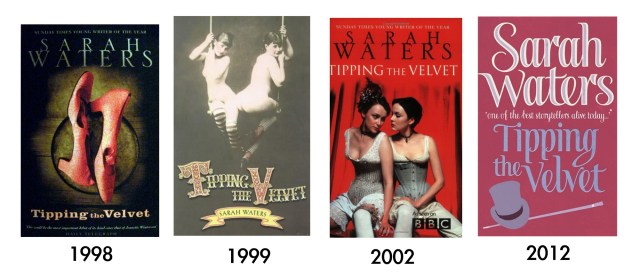
Please note: It’s possible that some of these dates are wrong! I found a lot of book covers that looked really contemporary but were cited everywhere as being from the ’70s or ’80s, and so I left those out, but I assume based on that experience that there are other inaccuracies as well, but I did my very best to verify the dates.



I have read all of these except for Annie on My Mind and The Price of Salt—clearly I have some lesbionic reading to do!
Also: Gilda Stories! ♥
Annie on my mind…made me cry. Also it changed my life. I would put it on the top 10 books that influenced me.
Annie on My Mind is so gutwrenching at times. I really identified with a lot of the feelings in this book. Highly recommended.
Annie on My Mind is a really sweet book! Though, TBH, at this point in my life I read the romantic bits and skip the [spoilers].
I read The Price Of Salt/Carol, and Annie On My Mind. They were fantastic and heartwarming. I also read Ann Bannon Books who was also a pioneer in Lesbian Pulp Fiction.
Liza on the 1992 “Annie On My Mind” cover looks a lot like me, which is one reason I picked the book up off my library shelf way back in 2004 or whenever. Changed my life, for real. Thank you, cover designer!
Ah Annie on My Mind was so influential to me as a queer confused 11-year-old, I remember checking it out of the public library and hiding it from my mother. Thanks for reminding me, I’m gonna do a reread!
I remember looking at Annie on My Mind in a bookstore when I was about twelve. I didn’t know what it was about; I had little to no idea what “gay” was, at the time. (I think I grew up under a rock.) So reading the cover just confused me, and I put the book back.
Five years later, when I started wondering if I liked girls, I went to the library and found it. I know what it’s about now.
This is amazing! The international Rubyfruit Jungle covers are blowing my mind!
this is an amazing collection!
Funny, I like the first Annie On My Mind cover best. I also love almost all of Jeanette Winterson’s covers.
I am on a mission to collect the covers of Tipping the Velvet with the half-naked girls and also the one with oysters.
Also: lesbian pulp covers! Amazing! Those international Rubyfruit covers! So good!
Unpopular opinion: I like Well of Loneliness. It’s a really interesting read, as long as you go in expecting tragedy. I also couldn’t resist getting this cover: http://pics.librarything.com/picsizes/50/84/5084877e2d213845932646c5741444341587343.jpg
It’s Tamara de Lempicka’s art, a queer woman who was painting at the same time period Hall was writing. Also, I have a (fictional) book about her, The Last Nude by Ellis Avery, which is fantastic. So now they match!
Wow, love this! I find that I’m rarely enchanted by the reprint cover of a book anymore, but I liked quite a few of these.
Why’d they change the name of “The Price of Salt”? Was it to associate “Carol” with Patricia Highsmith?
I think The Price of Salt is a much more memorable title for the book. I remember hearing about it and thinking it was one of those classic novels (rather than being classic pulp fiction!).
It has a sense of refinement to it, I guess.
i know i love the name “the price of salt” too!
i think maybe they changed the name because of a film adaptation called “carol” that’s shooting right now? with mia wasikowska and cate blanchett.
“Carol” was actually the title under which it was first published in the U.K. — so, not a modern innovation, though I’d guess the film is the reason for the most recent release. (Worth noting, too, that Carol’s not actually the protagonist, but rather the love interest of the protagonist, Therese.) And “The Price of Salt” itself is such a funny name — the phrase never turns up in the book, and you really have to be paying attention to even pick up on where she’s apparently pulling it from.
Thanks Daphne! We made the correction.
I prefer The Price of Salt, but there’s something satisfying about Carol, too. It makes me think of young Pat seeing the woman who inspired it & following her around by bus & subway. It speaks to the fixation.
I just realized from this gallery that all my (used) queer lit dates back to the 90’s. I still haven’t replaced a fallen apart copy of Annie On My Mind. Every time AS does an article like this I’m reminded, but never do anything about it.
I like how the ’92 and ’04 editions of The Color Purple don’t actually feature the color purple.
“We’re doing a reprint of The Color Purple. What should we put on the cover?”
“A giant yellow flower?”
“Perfect.”
I think that Chinese cover for Stone Butch Blues must actually be from Hong Kong or possibly Taiwan – it’s in traditional characters, which they don’t use on the mainland. I also would be surprised if a gay novel got published on the mainland.
The 2012 Bastard Out of Carolina is awesome! Jessi Sabogal is a major badass.
This is great! Obvs the older books with more editions are more illuminating, but the whole collection is fascinating – thank you very much for putting it together.
I think I prefer all the really old covers in almost every case. I have a real problem with modern book covers, so much that I get really frustrated, if not faintly disgusted, in new book stores. I think with older covers, even when they’re really atrocious (like that ’81 Well of Loneliness cover, which kind of reminds me of that terrible lesbian film called The Girl, which was so bad even I couldn’t sit through it), the retro-ness of them kind of deflects condemnation. Like we all just blindly accept that the 90s looked appalling with some kind of gooey sense of ownership.
Whereas now, there’s really no excuse for shite covers. People may have seen the Coverflip thing earlier this week. I think the grotesgue genderising is part of the problem, though I don’t really know how that plays with queer books.
Brilliant article. I think I like the development of the covers for The Well of Loneliness the best. That 1974 one is just awesome!
I’ve purchased 3 different copies of the Well of Loneliness, all with different covers. The first was just to have and read (it was a Triangle Classics one, I think, with a horse on the cover), and the second two were for the purposes of an artist book class. I went to a secondhand bookstore to get a copy to alter, and they had the 1959 cover as pictured above!!! which I obviously couldn’t cut up, so I got another one:
http://25.media.tumblr.com/15bf24824de34075b7c6f31221b4d30f/tumblr_mmoy47D3NI1rdfvh5o1_1280.jpg
aaand the craftsmanship is awful #dontjudgeme
What a fascinating display of covers–it’s wonderful to see the evolution of attitudes toward LGBTpeople and issues over the years reflected on book cover art–about which, by the way, authors rarely are consulted. I’ve often shown the Annie on My Mind covers to groups when talking about the book and about LGBT rights, etc.. The covers of foreign editions, by the way, are also fascinating. The very first one, from Britain, was a disaster; the girls look miserable, like losers. I was surprised and upset that Virago, of all presses, seemed to have such a negative view of two girls in love. But the book was published around the time that England issued an official directive against teaching anything positive about homosexuality in schools–so perhaps the cover was an attempt to appear to support that and thereby allow teachers to use the book.
By the way, I’m a member of the minority of lesbians who love THE WELL OF LONELINESS. Yes, it’s melodramatic and ends sadly–but Hall’s pleas at the end for justice and understanding led me to vow, at 16 when I read the novel, that I’d write a positive book one day about lesbians–and Annie on My Mind, years later after several failed attempts, was the result.
Again–what a wonderful piece this history via book covers is! Thank you for doing it–and thank you so much for including Annie!
Dear Ms. Garden,
Thank you for this wonderful comment. I, too, loved THE WELL OF LONELINESS. Melodramatic, indeed, but there is something of Stephen that I’ve never forgotten and carry within me; perhaps, it was her self-realization and inner-searching. If only she had had friends like Annie and Liza, as I found, when I was 11 in a mall bookstore in Ohio. She’d had found words and language, too, to help her on her way to knowing herself.
Thank you, Ms. Garden, for penning the positive book that would become the entry point to finding the language to assert the feelings and realizations about myself I already knew but couldn’t speak. ANNIE ON MY MIND remains one of my favorite love stories!
Go Cape!
Sincerely,
Angie
Dear Ms. Garden,
Thank you for this wonderful comment. I, too, loved THE WELL OF LONELINESS. Melodramatic, indeed, but there is something of Stephen that I’ve never forgotten and carry within me; perhaps, it was her self-realization and inner-searching. If only she had had friends like Annie and Liza, as I found, when I was 11 in a mall bookstore in Ohio. She’d had found words and language, too, to help her on her way to knowing herself.
Thank you, Ms. Garden, for penning the positive book that would become the entry point to finding the language to assert the feelings and realizations about myself I already knew but couldn’t speak. ANNIE ON MY MIND remains one of my favorite love stories!
Go Cape!
Sincerely,
Angie
What a wonderful, old school article, please more of those!!
These bring back memories. I own some of the vintage editions, like the 1951 Well and a 1977 Orlando that you haven’t in your list:
https://www.goodreads.com/book/show/13167122-orlando
Here is many more Orlando’s, if you want to dive in really deep: https://www.goodreads.com/work/editions/6057225-orlando-a-biography